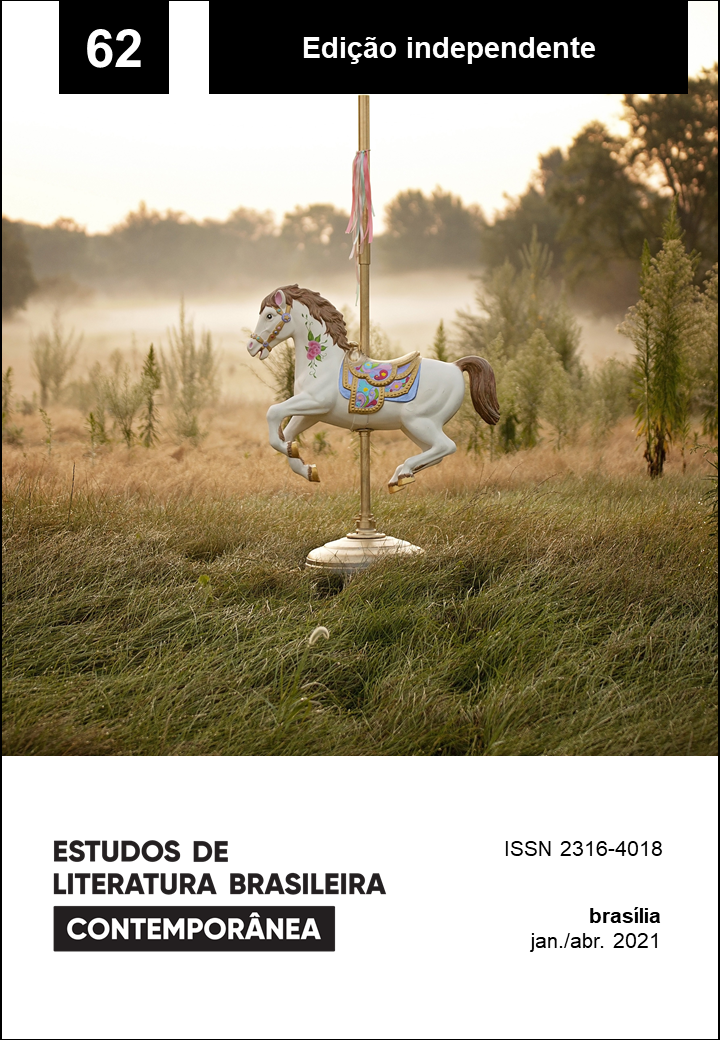The New Noah’s Ark: Animals and the Disapproval of the Civilization in Lygia Fagundes Telles’s Works
DOI:
https://doi.org/10.1590/2316-40186213Keywords:
Lygia Fagundes Telles, fiction, bestiary, human conditionAbstract
This article considers how animals are presented in Lygia Fagundes Telles’s writing, evaluating thematic choices, such as loneliness, cruelty or pessimism. This study analyses the significant role of the bestiary in her works, where the author uses talking, fantastic and symbolic animals to offer a critical portrait of a rich and complex bourgeois society peopled by a great variety of characters. Moreover, this study analyses the originality of Telles’ novels and short stories, noting the constant presence of literary animals as a fictional device, as a symbolic representation of society and as a way of questioning the value of social norms, ethical values and human’s own invention as civilized beings, drawing attention to the unnatural world we have created for ourselves.
Downloads
References
AGAMBEN, Giorgio (2002). L’aperto: L’uomo e l’animale. Torino: Bollati Boringhieri.
ANDRADE, Carlos Drummond de (1995). Antologia poética. 30. ed. Rio de Janeiro: Record.
BOTTING, Fred (1996). Gothic. London: Routledge.
CAMILLERI, Andrea (1996). Il ladro di merendine. Palermo: Sellerio Editore.
COELHO, Nelly Novaes (2002). Dicionário crítico das escritoras brasileiras. São Paulo: Escrituras.
DURAND, Gilbert (1985). Les structures anthropologiques de l’imaginaire. 10. ed. Paris: Dunod.
FINAZZI-AGRÒ, Ettore (2019). Amor, humor e terror na ficção de Lygia Fagundes Telles. Estudos de Literatura Brasileira Contemporânea, Brasília, n. 56, p. 1-21. Disponível em: https://periodicos.unb.br/index.php/estudos/article/view/22669. Acesso em: 11 fev. 2019.
GOTLIB, Nadia Batella (1985). Teoria do conto. São Paulo: Ática.
JACKSON, Rosemary (1981). Fantasy: the literature of subversion. London: Methuen.
PAES, José Paulo (1998). Ao encontro dos desencontros. Cadernos de Literatura Brasileira, São Paulo, n. 5, Lygia Fagundes Telles, p. 70-83.
RIVAS HERNÁNDEZ, Ascensión (2014). Narración y memoria en As horas nuas de Lygia Fagundes Telles. In: RIVAS HERNÁNDEZ, Ascensión; PEREIRA, Helena Bonito (Eds.). Relectura de Lygia Fagundes Telles. São Paulo: Editora Mackenzie; Ediciones Universidad de Salamanca. p. 13-32.
ROBLES, Mario Ortiz (2016). Literature and animal studies. New York: Routledge.
SANTIAGO, Silviano (1998). A bolha e a folha: estrutura e inventário. Cadernos de Literatura Brasileira, São Paulo, n. 5, Lygia Fagundes Telles, p. 98-111.
SCHOLES, Robert (1967). The fabulators. New York: Oxford University Press.
TELLES, Lygia Fagundes (s.d.). Ciranda de pedra. Lisboa: Livros do Brasil.
TELLES, Lygia Fagundes (1989). As horas nuas. 2. ed. Rio de Janeiro: Editora Nova Fronteira.
TELLES, Lygia Fagundes (1996). A noite escura e mais eu. Lisboa: Livros do Brasil.
TELLES, Lygia Fagundes (2002). Pomba enamorada ou Uma história de amor e outros contos escolhidos. Porto Alegre: L&PM Pocket.
TELLES, Lygia Fagundes (2004). Antologia: meus contos preferidos. Rio de Janeiro: Rocco.
TODOROV, Tzvetan (1970). Introduction a la litttérature fantastique. Paris: Éditions du Seuil.
VAX, Louis (1972). A arte e a literatura fantásticas. Lisboa: Arcádia.
Downloads
Published
How to Cite
Issue
Section
License
Copyright (c) 2021 Alva Martínez Teixeiro

This work is licensed under a Creative Commons Attribution-NoDerivatives 4.0 International License.
Authors who publish in this journal agree to the following terms:
a) The authors maintain the copyright and grant the journal the right of first publication, the work being simultaneously licensed under the Creative Commons Attribution License-Non Commercial 4.0 which allows the sharing of the work with acknowledgment of the authorship of the work and publication this journal.
b) Authors are authorized to enter into additional contracts separately, for non-exclusive distribution of the version of the work published in this journal (eg publish in institutional repository or as a book chapter), with authorship recognition and publication in this journal.
c) Authors are allowed and encouraged to publish and distribute their work online (eg in institutional repositories or on their personal page) after the editorial process, as this can generate productive changes, as well as increase the impact and citation of published work (See The Effect of Free Access).
d) The authors of the approved works authorize the magazine to, after publication, transfer its content for reproduction in content crawlers, virtual libraries and the like.
e) The authors assume that the texts submitted to the publication are of their original creation, being fully responsible for their content in the event of possible opposition by third parties.


